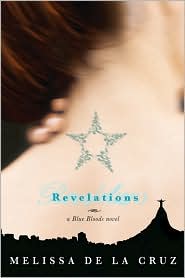Revelations, by Melissa de la Cruz
Nov 12
2008

I have an intense, long-standing, slightly guilty love for vampire stories, which allows me to tolerate literature I wouldn’t otherwise touch with a ten foot pole. This love might not be powerful enough for me to actually finish the Twilight books (even I have my limits), but it explains my enjoyment of Melissa de la Cruz’s Blue Bloods series, even though de la Cruz has made her name in my least-favorite YA genre—gossipy books about obscenely rich teens.
The Blue Bloods series focuses on a group of kids in an exclusive New York high school: artistic outcast Schuyler Van Alen, Texan transplant Bliss Llewellyn, and the nasty, popular Force twins, Jack and Mimi. de la Cruz’s book offers a twist on the typical Upper East Side high school saga, however—her characters are rich, self-indulgent, and self-obsessed, just like the characters in the Gossip Girl and Clique series, but they’re also the vampire reincarnations of the angels who sided with Lucifer. In the first two books in this series, Blue Bloods and Masquerade, Schuyler discovers her vampire heritage, falls in love with Jack Force, loses her grandmother to the mysterious vampire killers known as “Silver Bloods”, locates her long-lost grandfather, sexually ensnares her friend Oliver, and is forced to move in with the Forces. In the just-released third book, Revelations, Schuyler and her friends travel to Rio de Janeiro, where a battle with the Silver Bloods has earth-shattering consequences.
The books’ biggest flaw is de la Cruz’s shoddy characterization. The three female characters are cartoonish figures, largely defined by their clothing: nice-girl Schuyler wears threadbare vintage, evil Mimi wears haute couture, and Bliss, who hovers somewhere in between, wears not-quite-right designer outfits. (I am so tired of books that rely on name brands to flesh out their characters. Wearing Jack Purcell sneakers does not automatically equal “sensitive emo”, okay? I like Converse as much as the next girl, but they’re made by Nike, not some magical group of hipster cobblers.) And if de la Cruz’s female characters are poorly constructed, she does an even worse job with Jack. Rather than exploring his point of view, or even featuring him in more than a handful of scenes, she relies on exposition—we’re told Jack is totally dreamy, but all we see is a cryptic, Kafka-reading loser who’s simultaneously flirting with Schuyler, carrying a torch for her comatose mother, and getting all Flowers in the Attic-y with his twin sister.
While its tissue-thin characters are an undeniable drawback, de la Cruz’s series has its fair share of strengths. Her fallen-angel mythology is elaborate and creative, and her characters’ blood-sucking, globe-trotting hijinks offer a fresh take on the overplayed “wealthy teens run amok” genre. These might not be the most thoughtful, atmospheric, or seductive vampire novels on the planet (if that’s what you’re looking for, try Vivian Vande Velde’s excellent Companions of the Night), but they work just fine as a satisfyingly lurid fusion of two unlikely genres.
The Blue Bloods series focuses on a group of kids in an exclusive New York high school: artistic outcast Schuyler Van Alen, Texan transplant Bliss Llewellyn, and the nasty, popular Force twins, Jack and Mimi. de la Cruz’s book offers a twist on the typical Upper East Side high school saga, however—her characters are rich, self-indulgent, and self-obsessed, just like the characters in the Gossip Girl and Clique series, but they’re also the vampire reincarnations of the angels who sided with Lucifer. In the first two books in this series, Blue Bloods and Masquerade, Schuyler discovers her vampire heritage, falls in love with Jack Force, loses her grandmother to the mysterious vampire killers known as “Silver Bloods”, locates her long-lost grandfather, sexually ensnares her friend Oliver, and is forced to move in with the Forces. In the just-released third book, Revelations, Schuyler and her friends travel to Rio de Janeiro, where a battle with the Silver Bloods has earth-shattering consequences.
The books’ biggest flaw is de la Cruz’s shoddy characterization. The three female characters are cartoonish figures, largely defined by their clothing: nice-girl Schuyler wears threadbare vintage, evil Mimi wears haute couture, and Bliss, who hovers somewhere in between, wears not-quite-right designer outfits. (I am so tired of books that rely on name brands to flesh out their characters. Wearing Jack Purcell sneakers does not automatically equal “sensitive emo”, okay? I like Converse as much as the next girl, but they’re made by Nike, not some magical group of hipster cobblers.) And if de la Cruz’s female characters are poorly constructed, she does an even worse job with Jack. Rather than exploring his point of view, or even featuring him in more than a handful of scenes, she relies on exposition—we’re told Jack is totally dreamy, but all we see is a cryptic, Kafka-reading loser who’s simultaneously flirting with Schuyler, carrying a torch for her comatose mother, and getting all Flowers in the Attic-y with his twin sister.
While its tissue-thin characters are an undeniable drawback, de la Cruz’s series has its fair share of strengths. Her fallen-angel mythology is elaborate and creative, and her characters’ blood-sucking, globe-trotting hijinks offer a fresh take on the overplayed “wealthy teens run amok” genre. These might not be the most thoughtful, atmospheric, or seductive vampire novels on the planet (if that’s what you’re looking for, try Vivian Vande Velde’s excellent Companions of the Night), but they work just fine as a satisfyingly lurid fusion of two unlikely genres.
Posted by: Julia, Last edit by: Julianka
No new comments are allowed on this post.
Comments
No comments yet. Be the first!